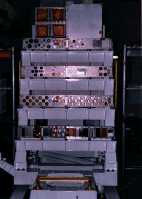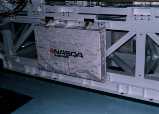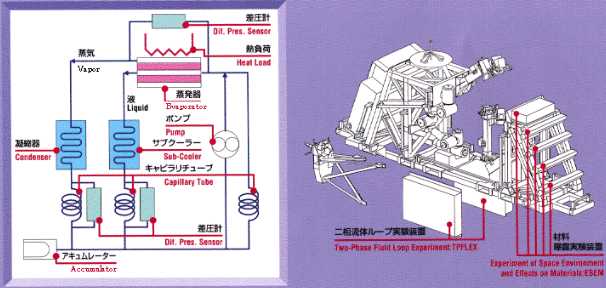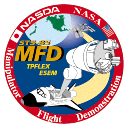Outline of Piggyback Experiments Onboard
the MFD Payload
- To Acquire Advanced Technologies for Future Space Utilization
-



- Evaluation of Space Environment and Effects on Materials
(ESEM)
The amount of space environment data is not enough to
research how parts and materials for space use change and deteriorate in space,
due to the difficulties of measuring space environment. Since ways to simulate
the space environment on the ground have not been established yet, it is necessary
that as much data on the space environment as possible be obtained by using flight
opportunities and evaluate these data in order to improve ground test technologies.
Taking the MFD flight opportunity, the following experiments will be performed
in cooperation with the National Aeronautics and Space Administration (NASA) Langley
Research Center.

- Atomic Oxygen Exposure Experiment (Material Sample Holder: MSH)
- This experiment evaluates material property changes due to exposure to atomic
oxygen. After material samples are returned to the Earth, the deterioration of
each material will be analyzed in detail.

- Cosmic Dust Collection Experiment (Cosmic Dust Collector: CDC)
- This experiment acquires data on the material, velocity, and number of cosmic
dust particles. During the flight, cosmic dust particles will be captured by the
Dust Collector. The properties of the cosmic dust particles will be analyzed in
detail after return to the Earth.


- Two-Phase Fluid Loop Experiment (TPFLEX)
The
Two-Phase Fluid Loop Experiment (TPFLEX) will verify basic thermal characteristics
of a two-phase thermal control system. The key concern of a control system is
how evaporators will be affected by the microgravity environment. Thus, the primary
objective is to obtain thermal properties of the evaporator in the microgravity
environment. Since the studies of a two-phase thermal control system in space
have just started, the TPFLEX is internationally recognized as a pioneering experiment.
The Multi-layer Insulator (MLI) and the Optical Solar Reflector (OSR) have been
used as a passive thermal control system for satellites and spacecrafts. For future
large satellites, the ability to discharge a large amount of heat into space and
to transfer heat to a distant location is required.
The two-phase thermal control
system, which controls the thermal condition of a spacecraft by the use of the
latent heat of a working fluid (water in this application) in a loop, is expected
not only to satisfy thermal control requirements but also to consume much less
electrical power than the conventional single-phase loop system.
Experiment
data will be used to confirm the two-phase thermal control technology and to design
the components of a two-phase fluid loop (heat exchanger, condenser, and cooler)
to be installed in the environment control system of future spacecraft.

Operation of Liquid Loop
The TPFLEX is composed of a liquid
loop and several electrical and electronic components.
A pump in the liquid
loop circulates a working fluid (water)in the loop along the directions of arrows.
Heat load is applied to the evaporator to vaporize water. In the evaporator, the
vapor phase of water is separated from the liquid phase, and the phases are transported
back to the pump through the vapor transport line and liquid return line. Heat
is transported to the condenser, where vapor is condensed to water in the form
of water's latent heat, where vapor is condensed to water, while heat is discharged
from the vapor into space.
![[HOME]](home.gif)
![[INDEX]](index.gif)
![[TOP]](top.gif)





